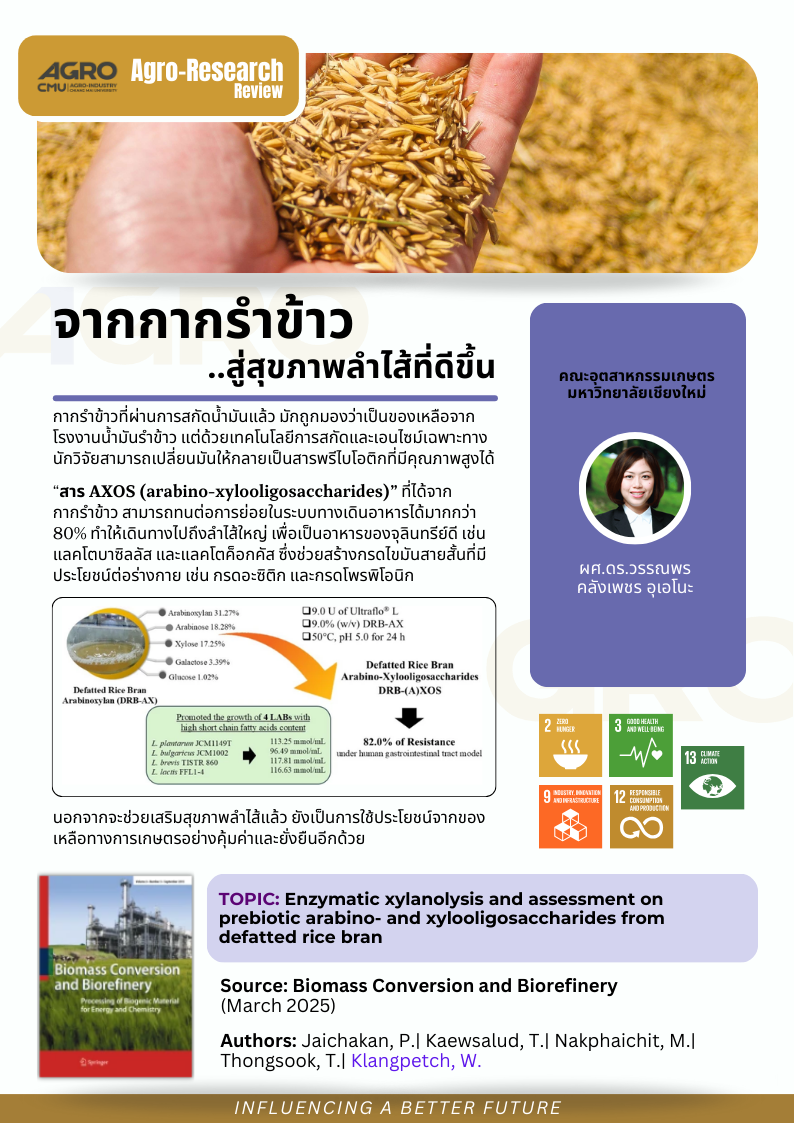
จากกากรำข้าวสู่สุขภาพลำไส้ที่ดีขึ้น
กากรำข้าวที่ผ่านการสกัดน้ำมันแล้ว มักถูกมองว่าเป็นของเหลือจากโรงงานน้ำมันรำข้าว แต่ด้วยเทคโนโลยีการสกัดและเอนไซม์เฉพาะทาง นักวิจัยสามารถเปลี่ยนมันให้กลายเป็นสารพรีไบโอติกที่มีคุณภาพสูงได้
สาร AXOS (arabino-xylooligosaccharides) ที่ได้จากกากรำข้าว สามารถทนต่อการย่อยในระบบทางเดินอาหารได้มากกว่า 80% ทำให้เดินทางไปถึงลำไส้ใหญ่เพื่อเป็นอาหารของจุลินทรีย์ดี เช่น แลคโตบาซิลลัส และแลคโตค็อกคัส ซึ่งช่วยสร้างกรดไขมันสายสั้นที่มีประโยชน์ต่อร่างกาย เช่น กรดอะซิติก และกรดโพรพิโอนิก
นอกจากจะช่วยเสริมสุขภาพลำไส้แล้ว ยังเป็นการใช้ประโยชน์จากของเหลือทางการเกษตรอย่างคุ้มค่าและยั่งยืนอีกด้วย
-
Defatted rice bran, often seen as a by-product from rice milling, can actually be transformed into a high-quality prebiotic ingredient through enzymatic extraction.
The resulting AXOS (arabino-xylooligosaccharides) resists digestion in the upper gastrointestinal tract—over 80% remains intact—allowing it to reach the colon and nourish beneficial gut bacteria like Lactobacillus spp. and Lactococcus spp. . These microbes then produce short-chain fatty acids such as acetic, and propionic acids, which are known to support digestive and metabolic health.
This process not only enhances gut microbiota but also adds value to agricultural waste, making it a sustainable solution for both health and industry.
-
Topic: Enzymatic xylanolysis and assessment on prebiotic arabino- and xylooligosaccharides from defatted rice bran
Authors: Jaichakan, P.| Kaewsalud, T.| Nakphaichit, M.| Thongsook, T.| Klangpetch, W.
Abstract:
Xylooligosaccharides (XOS) and arabino-xylooligosaccharides (A)XOS are prebiotic compounds widely used in functional foods to promote gut health. This study optimized alkali extraction (0.5 M NaOH, 40 °C, 6 h) to arabinoxylan (AX) from defatted rice bran (DRB), followed by xylanolytic hydrolysis (50 °C, pH 5.0, 24 h) using commercial xylanases (Ultraflo® L) to produce (A)XOS. The DRB-AX fraction, used as a substrate for (A)XOS production, contained 31.27% arabinoxylan, with 18.28% arabinose and 17.25% xylose. Under optimal conditions, (A)XOS yield reached 13.80%, primarily composed of xylobiose, xylotriose, 32-α-L-arabinofuranosyl-xylobiose, 33-α-L-arabinofuranosyl-xylotetraose, and some unidentified (A)XOS. Prebiotic analysis confirmed that over 80% of DRB-(A)XOS remained resistant to in vitro digestion, degrading into short-chain oligomers. Furthermore, fermentation with Lactococcus lactis FFL1-4, Levilactobacillus brevis TISTR 860, Lactiplantibacillus plantarum JCM1149T, and Lactobacillus bulgaricus JCM1002 stimulated the production of beneficial organic acids, including acetic acid, propionic acid, and lactic acid. These findings highlight DRB-(A)XOS as a potential prebiotic ingredient, capable of supporting gut microbiota while promoting the sustainable utilization of agro-industrial byproducts in food applications.
#อกมช. #agrocmu #CMU





